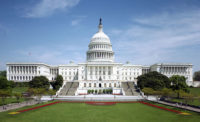WASHINGTON — John Somerhalder, chairman, president, and CEO of AGL Resources and past chairman of the American Gas Association (AGA), recently testified before the U.S. House of Representatives Energy and Commerce Committee’s Subcommittee on Energy and Power commending four specific legislative provisions included in the committee’s energy-efficiency and accountability discussion draft designed to remove barriers to the use of clean, energy-efficient, cost-effective natural gas.
In March, the U.S. Department of Energy (DOE) proposed a rule mandating natural gas furnaces must be manufactured to meet a 92 percent or higher energy-efficiency specification. At first glance, the rule appears to be a positive step forward for energy efficiency, but Somerhalder argued the DOE’s proposal may create a number of counterproductive and unintended consequences that could increase energy use and impose an undue burden on consumers. Section 4124 of the discussion draft addresses the development of fair, effective, and nonregressive energy-efficiency standards for residential natural gas furnaces.
“AGA is concerned that DOE’s current proposal for a new energy-efficiency standard for residential natural gas furnaces significantly overestimates the associated energy savings and greenhouse gas emission reductions the new standard would achieve while also unfairly imposing significant economic burdens on many American consumers — especially low-income households,” Somerhalder said in his testimony. “We are deeply concerned that, if not appropriately structured, this rule could prove to be the first energy-efficiency standard issued in the history of the DOE that has the real-world impact of increasing our nation’s overall energy consumption and carbon footprint. If finalized, AGA believes the rule would impose burdensome costs and renovations on many homeowners when replacing their natural gas furnaces.”
Section 4115 of the discussion draft will restore the ability of federal installations to benefit from the use of efficient and cost-effective end-use applications of natural gas in the long term. A part of Section 433 of the Energy Independence and Security Act of 2007 was intended to reduce fossil fuel-generated energy use in new and renovated federal buildings with a 100 percent reduction required by the year 2030. Due to the complexities of interpreting the law, however, the DOE has yet to issue a final rule implementing this requirement.
“The Section 433 fossil fuel ban is deeply flawed,” Somerhalder said. “Its implementation will severely limit — and ultimately prohibit — adoption of highly efficient technologies using natural gas at federal facilities, such as combined heat and power, fuel cells, and waste heat recovery systems. The U.S. is now the world’s leading producer of natural gas. The federal government should serve as an example to homes and businesses across the country by demonstrating how this clean, abundant, and domestic resource can increase energy efficiency, decrease overall emissions, improve our energy security, and save money.”
The DOE’s analysis of the fossil fuel ban indicates the provision will impose unacceptably high costs on the federal government, which will ultimately be borne by tax payers. The DOE estimates federal construction costs will jump from today’s level of $30 million annually to $536 million in 2019, when fossil fuel-generated energy must be reduced by 80 percent. Construction costs for federal buildings are estimated to jump again to $1.135 billion annually by 2030, when fossil fuel-generated energy must be eliminated. This projected surge in federal construction costs amounts to an increase of 3,783 percent.
Publication date: 6/1/2015
Want more HVAC industry news and information? Join The NEWS on Facebook, Twitter, and LinkedIn today!









